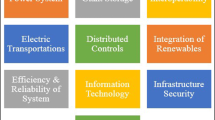Abstract
Smart grid (SG) is a dynamic distributed grid that the production, storage and users of electricity will work together under specific control, in which an important challenge is how to achieve unified control of distributed equipment on coordinating generators and users distributed in different geographical locations. The peer-to-peer (P2P) technology represents an open distributed network architecture with reliability, robustness and extensibility, which can be the candidate model for the smart grid system to manage power resources by combining with the edge computing. In this paper, we propose a P2P network based edge computing smart grid model that P2P networks is applied to edge computing layer. The innovation of the model is that the edge computing nodes can be used to collect, compute, and store data while the edge computing nodes are being peer-to-peer connected, by which can communicate with each other after data processing. By exploiting the proposed model, the experimental results of the extended ADMM algorithm show that there is a significant improvement in terms of energy resources management to decrease economic cost, increasing utilization of renewable energy as well as abilities of real time control.








Similar content being viewed by others
References
Brown RE (2008) Impact of smart grid on distribution system design,” in IEEE Power and Energy Society General Meeting - Conversion and Delivery of Electrical Energy in the 21st Century, pp. 1–4
Rahimi F, Ipakchi A (2010) Demand response as a market resource under the smart grid paradigm. IEEE Transactions on Smart Grid 1(1):82–88
Okay FY, Ozdemir S (2016) A fog computing based smart grid model, in 2016 International Symposium on Networks, Computers and Communications, Yasmine Hammamet, pp. 1–6
Zahoor S, Javaid N, Khan A, Ruqia B, Muhammad FJ, Zahid M (2018) A cloud-fog-based smart grid model for efficient resource utilization, in 14th International Wireless Communications & Mobile Computing Conference, Limassol, pp. 1154–1160
Yaghmaee Moghaddam MH, Leon-Garcia A (April 2018) A fog-based internet of energy architecture for transactive energy management systems. IEEE Internet Things J 5(2):1055–1069
Beidou F, Morsi W, Diduch C, Chang L (2010) Smart grid: challenges, research directions and possible solutions, in 2nd IEEE International Symposium on Power Electronics for Distributed Generation Systems, pp. 670–673
Hu L, Wen H, Wu B, Pan F, Liao R, Song H, Tang J, Wang X (2018) Cooperative jamming for physical layer security enhancement in internet of things. IEEE Internet Things J 5(1):219–228
Xie F, Wen H, Li Y, Chen S, Hu L, Chen Y, Song H (Oct. 2018) Optimized coherent integration-based radio frequency fingerprinting in internet of things. IEEE Internet Things J 5(5):3967–3977
Chen S, Wen H, Wu J, Lei W, Hou W, Liu W, Xu A, Jiang Y (2019) Internet of things based smart grids supported by intelligent edge computing. IEEE Access 7:74089–74102
Chen Y, Wen H, Wu J, Song H, Xu A, Jiang Y, Zhang T, Wang Z (1926, Apr.) Clustering based physical-layer authentication in edge computing systems with asymmetric resources. Sensors 19(8):2019
Yao Z, Leonard D, Wang X, Loguinov D (2006) Modeling heterogeneous user churn and local resilience of unstructured P2P networks, in Proceedings of the 2006 IEEE International Conference on Network Protocols, Santa Barbara, CA, pp. 32–41
Campos F, Matos M, Pereira J, Rua D (2014) A peer-to-peer service architecture for the smart grid, 14-th IEEE International Conference on Peer-to-Peer Computing, London, pp. 1–5
Song W, Zhao Y, Zhuang W (April 2018) Stable device pairing for collaborative data dissemination with device-to-device communications. in IEEE Internet of Things Journal 5(2):1251–1264
He Y, Yu FR, Zhao N, Yin H (2018) Secure social networks in 5G systems with mobile edge computing, caching, and device-to-device communications. in IEEE Wireless Communications 25(3):103–109
Anitha A, JayaKumari J, Venifa Mini G (2011) A survey of P2P overlays in various networks,” in 2011 International Conference on Signal Processing, Communication, Computing and Networking Technologies, Thuckafay, pp. 277–281
Nakayama T, Asaka T (2017) Peer-to-Peer bidirectional streaming using mobile edge computing, in 2017 Fifth International Symposium on Computing and Networking, Aomori, pp. 263–266
Krkoleva A, Borozan V, Dimeas A, Hatziargyriou N (2011) Requirements for implementing gossip based schemes for information dissemination in future power systems, in Innovative Smart Grid Technologies, 2nd IEEE PES Int. Conf. and Exhibitionon, pp. 1–7
Shen H, Li Z, Chen K (2015) Social-P2P: An online social network based P2P file sharing system, in IEEE Transactions on Parallel and Distributed Systems, vol. 26, no. 10, pp. 2874–2889, 1 Oct. 2015
Amann B, Elser B, Houri Y, Fuhrmann T (2008) A distributed P2P file system, in 2008 Eighth International Conference on Peer-to-Peer Computing, Aachen, pp. 77–78
Zhou Y, Ci S, Li H, YangY (2017) A new framework for peer-to-peer energy sharing and coordination in the energy internet,” in 2017 IEEE International Conference on Communications, Paris, pp. 1–6
Singh S (2017) Optimize cloud computations using edge computing, in 2017 International Conference on Big Data, IoT and Data Science, Pune, pp. 49–53
Martín Fernández C, Díaz Rodríguez M, Rubio Muñoz B (2018) An edge computing architecture in the internet of things,” in 2018 IEEE 21st International Symposium on Real-Time Distributed Computing, Singapore, pp. 99–102
Gentile U, Marrone S, Mazzocca N, Nardone R (2014) A cost-energy trade-off model in smart energy grids, in 2014 Ninth International Conference on P2P, Parallel, Grid, Cloud and Internet Computing, Guangdong, pp. 394–399
Boyd S, Parikh N, Chu E et al (2011) Distributed optimization and statistical learning via the alternating direction method of multipliers. Foundations & Trends in Machine Learning 3(1):1–122
Parikh N, Boyd S (2014) Proximal algorithms. Foundations and Trends in optimization 1(3):127–239
Acknowledgements
This work was supported by National Key R&D Program of China(2018YFB0904900, 2018YFB0904905).
Author information
Authors and Affiliations
Corresponding authors
Additional information
Publisher’s note
Springer Nature remains neutral with regard to jurisdictional claims in published maps and institutional affiliations.
Rights and permissions
About this article
Cite this article
Hou, W., Jiang, Y., Lei, W. et al. A P2P network based edge computing smart grid model for efficient resources coordination. Peer-to-Peer Netw. Appl. 13, 1026–1037 (2020). https://doi.org/10.1007/s12083-019-00870-9
Received:
Accepted:
Published:
Issue Date:
DOI: https://doi.org/10.1007/s12083-019-00870-9




